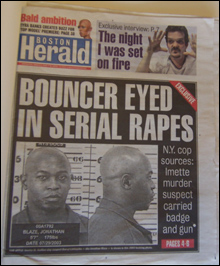The horrific New York murder of 24-year-old Imette St. Guillen — who grew up in Mission Hill and graduated from Boston Latin before studying criminal justice at M anhattan’s John Jay College — pitted the city’s two major dailies against each other in ways that reflect the strengths and weaknesses, as well as the editorial philosophies, of the two rivals.
anhattan’s John Jay College — pitted the city’s two major dailies against each other in ways that reflect the strengths and weaknesses, as well as the editorial philosophies, of the two rivals.
The St. Guillen tragedy — which is still unfolding and unfinished — certainly touched many of the papers’ readers on a visceral level. It also provided media watchers with insight into how the Globe and Herald operate at a time when old-school, head-to-head competition between the two dailies on a hot story is becoming a rarer event.
Cracking the case
The opening shot came from the Boston Herald on Monday, February 27, with a smallish page-six story — actually sourced to its sympatico cousin tabloid, the New York Post — with the somewhat understated headline: "Horror as popular hub woman slain in NYC." By the next day, the Boston tabloid was off and roaring, blowing out the front page to declare "Sheer evil: Cops hunt monster who killed hub beauty" while reporters Michele McPhee and Laurel Sweet described a murder “so vicious it stunned even the Big Apple’s hardened homicide detectives.”
Over on Morrissey Boulevard, the Globe was slower off the mark, getting into the story on the 28th with a piece in the lower right-hand corner of the Metro front — headlined "Mission Hill native found slain in NYC" — that consisted largely of interviews with neighbors and teachers of the victim.
On one hand, the brutal sexual assault and murder of a young, attractive, popular Boston woman on the mean streets of New York had all the ingredients of a classic tabloid saga that would be of more intrinsic interest to the Herald than to the Globe. But the financially strapped tab cut staff significantly last year — leaving it with only 13 news side reporters — and has made strategic decisions about which stories to chase, sometimes opting to ignore subjects certain to get the Globe’s — and the rest of the media’s — attention. And while the Globe might not be inclined to pursue a salacious, horrific crime with the passion of the Herald, editor Marty Baron has focused on hard-news reporting in his tenure and publicly declared his desire “not to be beaten by our competitors on any story of note.”
“We took it very seriously. Everyone involved worked very hard on the story,” says Globe deputy city editor Mike Bello. “I think we have nothing to be ashamed of . . . I thought we met the challenge.”
Says Herald senior executive city editor Eric Convey: “This is the kind of story the Herald cares about . . . I think we kicked ass.”
A review of the coverage reveals that the Herald — from late February to the middle of this month — ran roughly 50 stories and news columns on the St. Guillen murder. That’s about three times the number published in the Globe. And the Herald was indeed out in front on key aspects of the story — including naming primary suspect Darryl Littlejohn, possibly connecting him to other rapes, and foreshadowing the DNA match that is expected to secure his indictment.
One crucial date was March 6, when the Herald’s McPhee broke the news that police were “grilling” a “career criminal” named Darryl Littlejohn — a/k/a John Handsome, Jonathan Blaze, Damon Wells, and Darryl Banks — who was the last person seen with St. Guillen. The Globe’s unbylined late-edition story that day could only cite sources who told WHDH-TV (Channel 7) that an unnamed bouncer at the bar that the victim patronized was a “possible suspect.”
The following day, March 7, the Herald “flooded the zone,” to use a term connected to deposed New York Times executive editor Howell Raines. The page-one splash headline was menace to society as the paper produced a package of six stories and columns that included everything from McPhee and Sweet’s report that a parole board once referred to Littlejohn as a “menace to society” to a sidebar linking some of the suspect aliases to comic-book characters.
The Globe, naming Littlejohn for the first time, put the story on page one that day with the headline "Bouncer probed in NYC slaying."